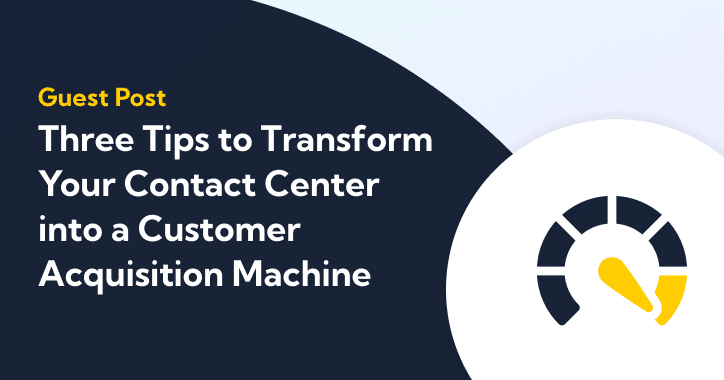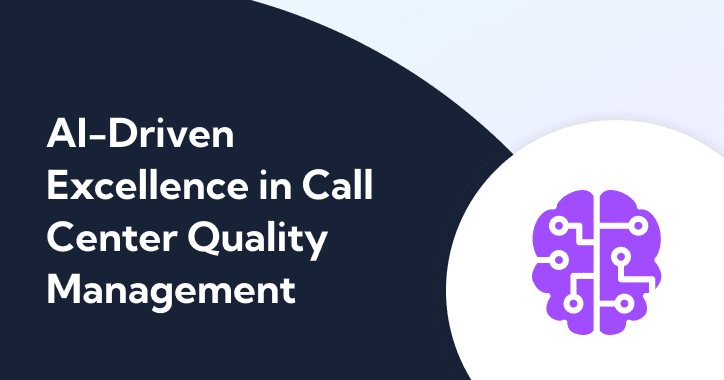With increased adoption of digital channels, competition from fintech services, and evolving customer expectations, the financial services industry has changed forever.
As customers seek seamless and personalized interactions with their financial institutions, the financial services industry is facing new challenges accompanied by opportunities for improvement, particularly in CX (Customer Experience).
For financial services providers, adapting to the fast-paced market shifts is crucial to thrive.
In this guide, we delve into the driving factors behind customer experience evolution, how you can develop a customer-centric culture, make the most out of emerging AI (Artificial Intelligence) tech, and maintain customer trust and loyalty.
The Current Importance of CX in Financial Services
Customer Experience in financial services is important for two main reasons: marketing and customer loyalty.
Many financial institution leaders don’t realize this, but providing a seamless customer experience is actually one of the most effective marketing tactics. In reality, most financial services providers don’t consider CX an urgent priority.
The truth is, in today’s digital age, customers expect you to provide them with personalized services and a smooth, omnichannel experience. A great customer experience goes hand in hand with customer loyalty.
If your customers are happy with the services you provide and are confident that they can rely on you when they face a challenge or need financial advice, they become much more likely to remain your customers for longer. On the flip side, a poor customer experience will make your customers angry and dissatisfied, leaving them no choice but to look for alternatives.
The Driving Factors Behind CX in Financial Services
There are two primary factors that raised the bar for CX in financial services:
Rising competition from fintech. Fintech providers have stormed the market with efficient systems and seamless customer support experiences. In comparison, traditional financial institutions are lagging behind.
Evolving customer expectations. The transformative shift to digital interactions has changed customer expectations to include 24/7 self-service and personalized and consistent digital experiences across different channels and platforms.
Harnessing Predictive Analytics for Enhanced CX
Utilizing predictive analytics enables you to gain accurate insights about what your customers need and expect from your institution.
The Need for Understanding Customer Desires in Customer Experience Management
A predictive analytics solution collects huge amounts of data across different customer touchpoints and calculates relevant metrics from your customers’ interactions, such as handling time, agent behavior, queue length, and other relevant call center metrics and KPIs. Other types of data that it collects include customer demographics, lifestyle, and interests.
Then, it analyzes the collected data and generates insightful reports about your team’s performance and customer interests, pain points, desires, and service satisfaction levels. These detailed insights enable you to create personalized experiences for your customers, which make it easier to foster long-lasting relationships with them.
By showing each customer that you “remember” that last issue they had with your services, you’ll earn their trust and boost customer retention.
The Power of Data Democratization for Employees and Customers
Data democratization involves making the data and insights derived from predictive analytics available to everyone in your organization.
Ensuring that your employees understand your customers’ needs and problems will encourage them to provide hyper-personalized customer experiences that include personalized service offerings, solutions, and recommendations.
This way, your customers will appreciate the personalized financial advice from your institution and be more willing to continue benefiting from your services.
The AI Revolution in Financial Services
Customer expectations are higher than ever, and if you fail to meet them, don’t be surprised if your customers jump ship to another financial services provider.
Think of it this way: each second that passes with your customer put on hold is lost business for you. Yes, in many cases, the customer’s call won’t generate any additional revenue for you, but it’ll significantly impact customer satisfaction and loyalty.
For many financial services firms, hiring additional staff may temporarily manage the increasing number of customer calls. However, as your organization grows and your product portfolio expands, the calls will just keep coming, and you simply can’t hire an infinite number of agents.
AI as a Growth Catalyst
Over the recent years, implementing AI-powered solutions has revolutionized the way customers interact with businesses. According to recent research by NTT Data, up to 80% of financial institutions believe that AI can give them a competitive advantage now and in the future.
Customers no longer need to call you whenever they face a small issue or technical difficulty. Instead of being put on hold or having to call your contact center during business hours, customers can now chat with AI chatbots that are available around the clock to resolve common queries and issues.
In case a customer needs further assistance, the AI chatbot’s integrated call routing capabilities will direct the customer to the best matching agent at the time of the query, contributing to a lower AHT (Average Handling Time).
Another convenient self-service option is the knowledge base. When your customer visits your website and types their query, presenting them with a list of matching solutions to their problem from the knowledge base can solve their problem faster.
At the same time, they may decide that a call is no longer necessary, so it’s a win-win situation here: Your customer found a solution to their problem faster, and your agents have one less customer to deal with, boosting their productivity.
Some banks and financial institutions have taken AI implementation one step further by providing customers with tutorials and tips and tricks that can help them make the most out of their services.
Conversation Intelligence: Gauging Customer Sentiments
Conversation intelligence software uses Natural Language Processing (NLP) and machine learning to gauge customer sentiment. It collects and analyzes big data across different customer touchpoints, translates the text and speech into machine-readable language, and carries out sentiment analysis that helps understand customer emotions and intent.
Conversation intelligence tools with basic sentiment analysis capabilities will provide rule-based sentiment gauging – They simply inform you whether the customer’s experience was positive, negative, or neutral. More advanced conversation intelligence platforms utilize deep learning to capture emotions.
The models used in conversation intelligence continue to learn and provide better results as you feed them with more data, ensuring accurate customer sentiments that only get better over time.
With the insights you get from conversation intelligence solutions, you’ll be able to understand what your customers need and improve the overall customer experience.
Unifying Customer Communications
Maintaining a cloud-based communications platform helps your agents seamlessly interact with customers across different channels. With a unified inbox and customer interaction history, agents can provide customers with the assistance they seek regardless of the communications channel they choose.
The platform records every single customer interaction and enables agents to take notes, which other agents can see when they follow up with the customer. Additionally, advanced communication platforms integrate call routing capabilities that ensure the customer is routed to the most qualified agent for their query. This is especially important for financial services organizations with a highly diversified product portfolio, with agents that are licensed for particular products.
This ensures that the customer can get their problem solved as quickly as possible with minimal wait time, fewer call transfers, and less back and forth.
Greater Transparency Around Data Usage
Working with large quantities of customer data can help you make better decisions and improve customer experience.
However, Collecting data about your customers should be done in a way that ensures the proper handling and securing of this data. It’s also vital to ask for customer consent before proceeding with data collection.
For example, if your contact center records phone calls for QA purposes, you must get verbal consent from the customer before you initiate recording.
Further, financial institutions must provide full disclosure on how they collect, store, and secure customer data to increase customer trust. It also helps your organization meet different compliance laws and regulations such as GDPR (General Data Protection Regulation) and CCPA (California Consumer Privacy Act), which further boosts your brand image.
Another good practice is to rely on zero-party data rather than third or first-party data. Zero-party data is data that customers willingly submit to the organization. It’s accurate and helps financial institutions make more realistic forecasts.
The tricky part is to convince customers to spare a few minutes of their time to submit the data. You can offer rewards for your customers to encourage them to provide you with personal information and explain how this can help improve their experiences.
Transforming Your Physical Branches
Traditional physical branches for banks and other financial institutions have been largely neglected in favor of developing Internet banking and digital service gateways.
And while ensuring a seamless online experience for your customers can definitely save them time and effort, that doesn’t mean there’s no room for improvement in your physical branches.
And no, we’re not talking about those free cups of coffee and complimentary Wi-Fi access you give your customers when they visit your physical branches. Instead, you can improve customer experience in physical branches by incorporating customer training venues with showroom-style designs.
A customer training venue may include video and interactive training materials that provide consultant and financial advice to customers, while a showroom-style branch can include tablets that have the institution’s mobile app on them with step-by-step tutorials and tips and tricks on how to fully utilize them.
Additionally, you can include self-service kiosks, enabling customers to get instant help with any of the services they use. Ideally, you’d want these kiosks to offer hyper-personalized offers and services that cater to each customer’s needs.
However, it’s important to make it easier for customers to log in without wasting their time. Advanced facial recognition and text OTPs (One-Time Passwords) would work great here.
Automated Onboarding
Onboarding is no longer a thing that you only need to do for your new staff hires; customers need to go through a seamless onboarding experience too, especially with the increased reliance on technology and digitization in service delivery.
A clear, high-quality onboarding process that doesn’t involve signing an endless number of paper documents and agreements can create just the right first impression for your customers.
Instead of focusing on routine bureaucracy, a modern onboarding process should place more emphasis on familiarizing the customer with the tools and services they can take advantage of and how to make the most out of them, while paper signing and other routine stuff should be handled electronically.
Cultivating a Customer-Centric Culture
Developing a customer-centric culture requires spreading company-wide awareness about what results in a consistent customer experience.
Customer centricity involves understanding the customer’s problems, feelings, and service level expectations. To deliver an optimal customer experience and foster a customer-centric culture, it’s vital for you to put the customer first throughout the decision-making and product and service design processes.
Educating your agents about the importance of a customer-centric approach and how their actions can affect the customer experience is essential.
Getting your agents familiar with different tech tools and how each tool can improve CX can make them more willing to satisfy customers.
By creating a customer-centric culture, the changes will gradually reflect on how your customers perceive your institution.
The Organizational Ripple Effects of a Customer-First Mindset
Most Customer Experience (CX) programs place more emphasis than necessary on transactions, where customers can report their satisfaction level with a simple post-transactional customer feedback survey.
This approach has worked in the past, but today, it’s far from being sufficient. The main criticism of this strategy is that it treats each customer interaction as an independent occurrence, which makes it challenging to improve the overall customer experience and create hyper-personalized interactions.
A more effective approach is to focus on viewing the entire customer journey as a whole instead of focusing on individual transactions. It involves developing a deep understanding of how your customers interact with your institution across different channels to achieve more tangible customer experience improvements.
According to recent research, companies that develop a customer-first mindset report 60% higher profits than companies that treat CX as a non-urgent matter.
Every tiny interaction between you and your customer causes a “ripple effect” across your entire organization. In other words, one interaction handled inappropriately can jeopardize your entire customer experience strategy.
Creating a more comprehensive CX strategy that adopts a customer-first ideology involves three key steps:
- Establish a unified CX strategy. Ensure that everyone in your organization is on the same page by developing a unified vision of customer experience and the metrics and KPIs used to track and measure it. Create a customer journey map and involve relevant departments and stakeholders.
- Assign a single leader responsible for your CZ program’s implementation and success. Determining who’s responsible for improving customer experience in your financial services institution is crucial for ensuring its success. Choosing the right leader should be based on the level of visibility they have over the institution and their capability to provide top management with KPI reports and results.
- Increase awareness across the entire organization. Improving customer experience requires collective efforts from everyone in your organization, from customer-facing representatives all the way up to board members and CEOs. This helps align your teams and keep everyone focused and motivated to contribute to your customer experience initiatives.
- Improve your employee experience. Employee experience can have a huge impact on the customer experience. Training and coaching your agents, in addition to making sure that all of them are actively participating in your CX improvement strategy, can help you direct your efforts more effectively and accelerate positive results. Design new efficient workflows for your teams that focus on creating a positive customer experience and collect feedback from your team on their implementation.
Implementing these steps will help you approach customer experience from a more holistic perspective, enabling you to fully understand it and improve relevant KPIs. Again, the key here is to make everything at your organization involved.
The Balance of Digitization and Human Touch
Many financial services providers have adopted AI-powered solutions to improve customer experience. While these technologies have definitely contributed to more efficient customer service, reduced wait time, and increased agent productivity, customers still need that human touch in certain aspects of their interactions with your organization.
The key here is to maintain enough balance between human and AI interactions. A widely accepted practice is to utilize AI in areas where direct human intervention is usually not necessary, such as common customer queries and problems that already have straightforward answers in your knowledge base.
Financial services institutions can utilize AI chatbots and assistants that use natural language processing and customer sentiment analysis to pull relevant answers from the knowledge base. For more complex queries, customers may ask to talk to a human agent to explain their problem and find a solution for it.
Further, many financial institutions are working on improving their AI solutions to incorporate more natural chatbot-customer conversations with personalities and human-like tone of voice, while leaving agent assistance as a final resort for the customers.
Reinforcing Training and Employee Motivation
Training your employees is vital for a seamless customer experience in the financial services industry. Even your best agents can occasionally underperform, and in many cases, a refresher is all they need to get back on track.
This type of training is called “reinforcement training”. The purpose behind it is to maintain consistent agent performance, which in turn, provides a frictionless customer experience.
The key here is to identify common mistakes and prevent them from becoming habits by reviewing recorded customer interactions and spotting issues that may negatively affect customer experience.
It’s also vital to create personalized reinforcement training sessions for each agent to touch on their weak points and work on improving them. Moreover, you need to make sure that all your agents are capable of fully leveraging the tech tools and resources available to them.
Reinforcement training sessions should be carried out periodically. Ideally, you’d want to initiate a reinforcement training session on a quarterly basis to evaluate agent performance and work on fixing problems before they lead to lost customers.
The Necessity of Consistency in Service Delivery
Providing a consistent, omnichannel communication experience for your customers is one of the driving factors behind customer loyalty.
In this day and age, customers expect financial services organizations to respond to their queries and remember their past interactions and what problems they had, regardless of which channel the interaction took place on.
For example, if a customer calls you about a problem with their account, and later, they send you a follow-up message on Facebook while they casually scroll through their news feed, they’d expect you to be aware of the problem and provide instant updates on its status.
To ensure a consistent experience across different channels, you need to create a straightforward customer journey and integrate omnichannel support with a unified platform that contains customers’ historical data and interactions.
Striking a Balance: Data Security and Customer Convenience
Customer convenience shouldn’t come at the expense of compromised data security.
The federal government has passed multiple customer data security and privacy laws and Know Your Customer (KYC) regulations in recent years. Complying with these regulations in practice typically leads to more verification and security steps, which may frustrate your customers and negatively impact the customer experience.
On the contrary, earning customers’ trust by assuring them that their sensitive information is in safe hands can have a positive influence on customer experience. Many customers in the financial services sector are confident that financial services institutions are capable of keeping their critical data safe.
However, there’s no guarantee that a security threat won’t turn into a breach, which can have a severely negative impact on customer trust that increases exponentially with every subsequent attack.
For many financial services organizations, hitting that sweet spot between ensuring security and maintaining a seamless customer experience is the real challenge.
There are many things that can be done here. For example, organizations can clearly communicate to their customers the importance of the security measures they’ve implemented to protect their sensitive data. Another way to keep disruptions at a minimum is to integrate advanced security and authentication tools that enable customers to go through different authentication and security steps quickly and effortlessly.
If a customer has to wait more than a few seconds to receive an OTP (One Time Password) text message on their phone in a typical 2FA (Two Factor Authentication) implementation, you have an opportunity for improvement here.
The Role of Solutions from Balto in CX
Balto’s AI-powered solutions can help you take your customer experience to the next level with real-time analytics and coaching capabilities.
Real-time Insights from Balto Reports
Balto’s real-time insights and reports have eliminated the guesswork out of customer experience. With data-driven analytics, you can easily identify what customers don’t want.
By utilizing Balto’s Win Rate Analysis, you can A/B test different phrases to see which of them performs better, and once you have a winner, you can instantly share scale your findings with your entire support team.
What’s more, Balto automatically scores 100% of calls for quality assurance. Compared to traditional scoring that relied on random call samples, this method is faster and more accurate, enabling you to quickly capture the causes behind the low scores and work on preventing mistakes from becoming habits immediately.
Using Analytics to Inform Employee Training and Development
Balto’s AI and ML-powered analytics enable you to identify your agents’ weaknesses and tailor personalized coaching and training sessions.
Using Balto’s Playbook Designer, you’ll be able to instantly scale ideal conversations to your entire team. Further, you can customize alerts for key moments in conversations so you can intervene to assist your agents before the call results in a lost sale or dissatisfied customer.
On top of that, you can use Balto’s gamification features to keep your agents engaged and motivated.
The Road Ahead for Financial Services Organizations
Customers are increasingly relying on digital communication channels to interact with their financial services providers. This is a trend that will continue for years or even decades to come, and financial services organizations need to adapt to survive.
Financial services institutions need to create personalized digital experiences for their customers. Since customers expect financial services providers to know their history, preferences, financial status, and what they need or may need in the future, generic digital experiences no longer cut it.
With a so-called “content anywhere” approach, integrating data-driven insights from past customer interactions throughout your entire digital ecosystem will provide your customers with that personalized digital experience they desire.
This approach will enable financial services organizations to compete with modern fintech organizations that provide lucrative, customer-first digital experiences that focus on hyper-personalization.
Leverage Balto to Elevate Your Financial Services Customer Experience Strategy
Balto helps you provide exceptional customer experiences across your whole digital landscape.
Your agents are missing the key tools they need to come up with fast and accurate answers to customer queries, resulting in frustrated customers and lost business.
Another challenge is the lack of effective coaching which results in skills gaps and agent performance issues. Your agents often find themselves in complex situations with customers every day, but without having a sustainable method to track and influence your agent behavior, the status quo will continue to prevail.
Balto empowers your agents with real-time access to the information they need to provide faster and more consistent assistance to your financial services customers, reducing hold and wait times and improving the overall customer experience.
Exceed customer expectations by using data-driven insights from Balto to understand your customers’ intent and preferences. Utilize real-time coaching to coach your agents as soon as they need your support, with automatic alerts for coachable moments that allow you to quickly join calls and provide guidance. Provide automated assistance to your agents with AI-generated prompts and responses that help them navigate complex situations smoothly.
Ready to propel your financial services customer experience efforts forward? Try Balto with a free demo today and experience how it can revolutionize your customer experience in action.






